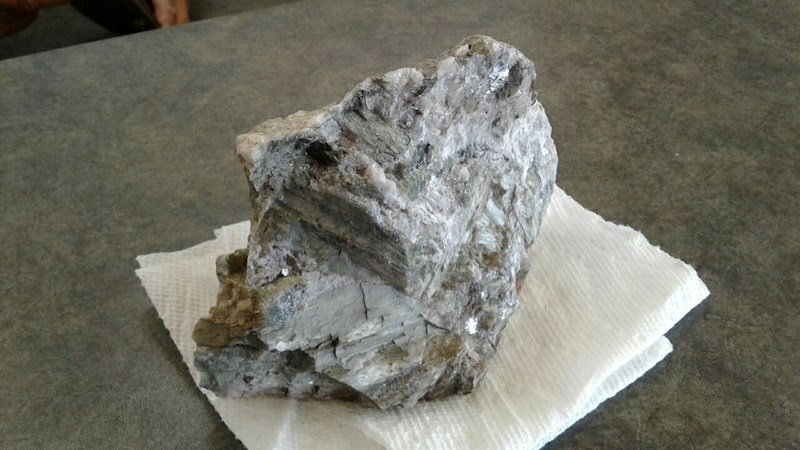On July 9, 2018, Far Resources Ltd. announced they have received the first ever resource estimate for Dyke 1 on the Zoro Lithium Property; located on the east shore of Wekusko Lake.
The estimate reports that Dyke 1 contains an inferred resource of 1,074,567 tonnes grading 0.91 per cent Li2O (Lithium oxide), 182 ppm Be (Beryllium), 198 ppm Cs (Caesium), 51 ppm Ga (Gallium), 1212 ppm Rb (Rubidium), and 43 ppm Ta (Tantalum), at a cut-off of 0.3 per cent Li2O. As well, the dyke is open at depth and to the north and south, where additional exploration is ongoing.
“The estimate has an effective date of July 6, 2018, and was prepared by Scott Zelligan P. Geo., an independent resource geologist of Coldwater, Ontario,” the company announced. “Dyke 1 is one of eight known spodumene-mineralized pegmatite dykes on the property. The remaining dykes are currently the object of ongoing exploration including drill-testing.”
Toby Mayo, President and CEO, commented, “This maiden resource, which covers part of Dyke 1, indicates that we have a substantial base on which to build. In addition to the other seven dykes that are not included in this resource, the Company has numerous untested geological and geochemical targets that we will follow up on during the next phases of exploration at Zoro. We look forward to developing those targets in the coming months.”
The estimate is based on 22 drill holes drilled by Far Resources at Dyke 1 from 2016 to 2018 and it was noted that inferred mineral resources are not mineral reserves.
“Mineral resources, which are not mineral reserves, do not have demonstrated economic viability, Far officials said. “There has been insufficient exploration to define the inferred resources as an indicated or measured mineral resource. However, it is reasonably expected that the majority of the Inferred Mineral Resources could be upgraded to Indicated Mineral Resources with continued exploration. There is no guarantee that any part of the mineral resources discussed herein will be converted into a mineral reserve in the future.”
A NI 43-101 technical report in respect of this estimate will be filed on SEDAR within 45 days of July 9, 2018.
The following day, Far announced the discovery of a large 1.5 km long and up to 100 m wide Mobile Metal Ions (MMI) soil geochemical anomaly for lithium on the Zoro Lithium Project. The lithium and related element anomaly was defined by data interpretation for soil samples collected by the Company’s field crews during surveys conducted in the fall and winter of 2017.
The Company says that they view this anomaly as significant, based on the discovery of its eighth spodumene-bearing pegmatite dyke, resulting from drill testing of an MMI lithium anomaly in 2017. A drill hole testing the MMI anomaly intersected 36.5 m of spodumene-bearing pegmatite. Assay results from the hole included three separate intercepts of high-grade lithium including 12.3 m of 1.1 per cent Li2O, 4.4 m of 1.2 per cent Li2O and 2.2 m of 1.5 per cent Li2O. The mineralized zone is open in all directions.
Far advises that it is noteworthy that numerous additional MMI lithium anomalies have been delineated on the Zoro property and together with the new lineament anomaly represent drill targets.
“We have always believed that the potential for further discovery at Zoro is great,” said Mayo. “The successful use of MMI in the discovery of Dyke 8 during our last drilling campaign appears to be just the tip of the iceberg, with this new data set highlighting many more targets, including our largest to date. The upcoming MMI survey expansion is bound to highlight many more targets. We remain committed to this exciting project, and this data confirms our conviction. Our winter drilling programme at Zoro looks to be very exciting.”
Mobile Metal Ions Technology is a proprietary method used to measure low concentrations of metals in soil. Target elements are extracted using weak solutions of organic and inorganic compounds rather than aggressive acid or cyanide-based digests. MMI solutions contain strong ligands, which detach and hold metal ions that were loosely bound to soil particles by weak atomic forces in aqueous solution. This extraction does not dissolve the bound forms of the metal ions. The metal ions in the MMI solutions are the chemically active or “mobile” component of the sample. Typically, the mobile, loosely bound complexes are present in very low concentrations and so measurement is by conventional ICP-MS (inductively coupled plasma mass spectrometry).
Far Resources is actively drilling their Zoro Lithium project, which covers a number of known lithium pegmatite occurrences. The Company has recently acquired an option on the Hidden Lake Property in NWT and is initiating drilling for continuity of spodumene mineralization to depth. In the United States, the Company controls the Winston project in New Mexico, a historic mining property with additional potential for silver and gold.




